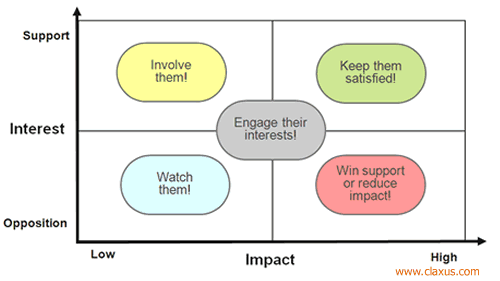Managing stakeholder expectations can feel like steering a boat through rough seas.
The “seascape” around the project is constantly changing:
- Corporate politics blow from all directions
- Resource shortages may dash the project on the rocks
- Technology and market forces pull in directions that are unpredictable and uncontrollable
In this article I introduce an approach for managing stakeholders to maximize support and minimize interference.
Steps to Managing Stakeholders
The following steps will keep your stakeholder relationships on course throughout the project life cycle.
- Identify people who have an interest (positive or negative) in the project.
- Understand each person’s interests and potential impact on the project.
- Group stakeholders according to common interests and levels of power.
- Set a strategy for managing your relationship with each group.
- Plan communication actions and apply influence principles to implement the strategy.
Identify Your Stakeholders
Stakeholders have one thing in common: they care about the project. Identify everyone who could (or should) have an interest in what you are doing. Some will benefit from the outcome. Others may fear the changes.
Ask yourself:
- who will benefit from the product (or service)?
- who might be interested in the technology we use to develop it?
- who stands to lose when the project is completed?
Don’t stop with the obvious – customer, sponsor, team. Identify stakeholders both inside and outside your organization. Consider managers of other departments from whom you may need to borrow resources, other project managers who could profit from your best practices, concerned citizens, politicians and others.
Stakeholders are individuals, not groups. While it may be tempting to identify the „marketing department“ as a stakeholder, marketing is not a stakeholder! The product manager might be; the new marketing associate could be. Each person has unique interests and preferences. By identifying individuals instead of groups, you will be better able to tailor communications for them.
The “B” word. Let’s face it: your project is not for everyone. By identifying blockers, you might be able to minimize the negative impact the project will have on them. While this will not always win their support, it usually will reduce opposition.
Understand Interests and Impact
Discuss the potential impact of each stakeholder with your core team. Since you will be talking about power and influence, agree on the Vegas rule: “whatever is discussed in the room stays in the room.”
Impact does not correlate with the org chart. Impact on the project is not the same as power in the organization. A technician may have high impact because of her expertise, whereas the head of an unrelated business unit may have little impact on the project.
Cherish supporters… but ask why. It’s great to have supporters, but do you know why each person supports the project? What’s in it for them? Discuss this with your team until you reach a consensus on each supporter’s motivation. Without knowing why someone supports you, maintaining that support is a matter of luck.
Know the opposition. Understanding the reasons behind opposition is just as important as knowing the reasons for support. Perhaps someone is not convinced about your choice of technology. Or they fear you will pull resources away from critical projects. Address these concerns! Identify respected people who evaluate the technology favorably. Work out a resource sharing plan with other projects. By doing so you might turn the wind of opposition into a gentle supporting breeze.
Below is an example of a completed stakeholder interest/impact analysis.
Group Stakeholders and Tailor Communications
Marketers target communications at customer segments—people who share common interests, habits or preferences. For good reason. This streamlines communication and increases impact. You can do the same. Tailor project communications for specific stakeholder groups. Some ideas:
- host a discussion forum for power users
- conduct one-on-one meetings with resource managers
- send out a monthly Tech Brief for technophiles
Group stakeholders based on common interests, not on level of support! People support the project for different reasons. Supporters may not all be interested in the same information. The Head of R&D may be interested in the technology while the VP of Marketing is excited about new features. These people need different communications.
Set a Strategy for Each Group
The truth is you won’t be able to turn everyone into a high-impact supporter. Set realistic goals for each stakeholder group, using the chart below as a guide.
High-Impact Supporters: Keep Them Satisfied!
Ask for actions. High-impact supporters want you to succeed but may not know the best way to help. Find a role that suits each person’s interests and position. Then ask them for specific actions. Get the CIO to talk to other CIOs. Ask a manager to spread the word within her department. Send a tech-savvy supporter to meet with techies at a customer organization.
Low-Impact Supporters: Involve Them!
Low-impact supporters may need a boost from you to get going. Inform them about project status, milestones and important decisions. Groups are more powerful than individuals—look for ways to bring lone supporters together. If a community forms around your product or service, support it! Consider creating a community if it doesn’t already exist. You’ll find more tips in this article on building communities in this article.
Low-Impact Opposers: Watch Them!
You might be tempted to ignore low-power blockers, focusing your energy instead on satisfying supporters or converting high-power opposers. However, when you ignore blockers, you do so at your peril. Their degree of power over the project could quickly change.
Let’s say you ignore a department manager who is a low-power blocker because she has no direct authority over the project. Then, after a restructuring she is responsible for your product line. Her first action may be to slash your budget.
Build relationships in advance. Instead of ignoring the blocker, find out why she opposes the project. Perhaps you discover she favors an alternative technology. After researching the technology, you might conclude it would also satisfy project requirements. You can then integrate the technology and gain a supporter.
Public works projects (roads, airports, etc.) often have many low-impact opposition groups. Smart project managers seek dialog with these groups before conflicts arise, looking for ways to address their concerns while still delivering project results.
High-Impact Opposers: Win Support or Reduce Impact!
The rule is… pick one. Winning support or reducing impact require different methods. Win support where you can. Uncover the reasons why the person opposes the project and address the issues where you can. When you can’t address these issues directly, look for things you can agree on. Start small and build from there.
Know when to hold ‘em and know when to fold ‘em. Some stakeholders will be opposed to the project for reasons you cannot rectify. You will not turn these people into supporters no matter how hard you try, so don’t try. The best strategy here is to reduce their impact on the project.
Silence opposition by demonstrating support. By displaying social proof for the support you already have, you increase the risk for someone to openly oppose the project. If a stakeholder sees other people supporting you, she may jump on the bandwagon as you race towards the finish line. No one likes being left out of a winning proposition.
Stuck in the Middle: Engage Their Interests!
Show relevance. People who neither support nor oppose the project may not see the relevance of the project for them. If the project will benefit them, let them know! The best person to deliver the benefit message is someone the stakeholder respects and trusts.
Don’t try to hush it up. Will you project negatively affect someone? Consider letting them know about negative consequences in advance. Don’t kid yourself, they will figure it out anyway. Use the opportunity to work with them to reduce the negative impact. While it is not possible to eliminate all negative consequences, the fact that you tried will help your working relationship.
Photo credit: Ville Miettinen





